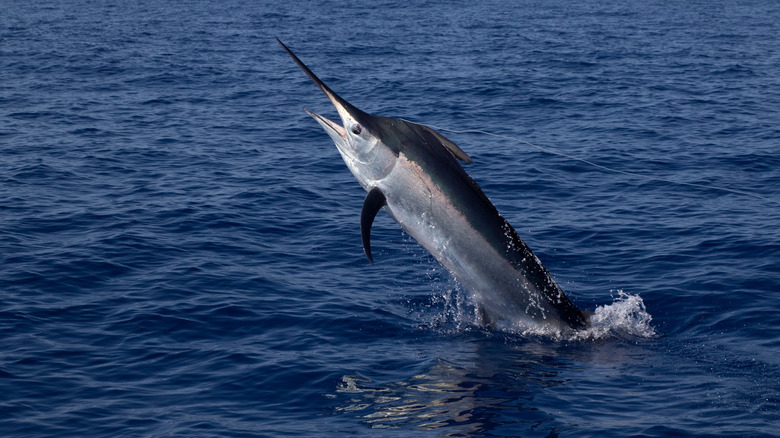The Unexpected Fish That Contains The Highest Amount Of Mercury
The risks of mercury levels in canned tuna are well-known, but we often forget to take fresh fish into account. It's prudent to be aware of the fish that are safe to eat regularly, and it's equally important to know which types have the highest levels of mercury and are best consumed sparingly. According to the FDA, tilefish from the Gulf of Mexico contain the highest amount of mercury, with 1.123 PPM (mercury concentration mean). For comparison, bigeye tuna has 0.689 PPM. The FDA has set the highest allowable average mercury concentration in fish at 0.46 micrograms per gram per week, which means opting for fish with high levels drastically limits how much you can enjoy weekly.
Tilefish is a white fish found in waters from Florida to Canada, but its high mercury content is location-dependent. Tilefish from the Atlantic Ocean contain lower levels than the Gulf of Mexico variety, with just 0.144 PPM. Due to its vibrant array of colors and tropical look, tilefish is also commonly known as rainbow tilefish or golden snapper, and is often lovingly referred to as the "clown of the sea." The meat is firm and flaky, and has a milder flavor that some say is akin to crab or lobster.
Other popular fish that end up on your plate and contain high amounts of mercury include swordfish, king mackerel, and marlin. Though the levels vary depending on the type, just about all fish and shellfish contain at least a trace of mercury.
What to know about mercury in fish
Mercury is a heavy metal found naturally in the earth's crust, and small amounts are found in rocks, water, and soil. Man-made pollution also ends up emitting mercury into the atmosphere. Once it's in the air as a byproduct of human activities, it will eventually end up back in the ocean and other large bodies of water.
Bacteria in the water then convert it into a highly toxic form of mercury. Plankton eats it up, and it enters the food chain. The smaller fish feast on the plankton, and the larger fish feast on the smaller fish ... and humans feast on them all. The higher you move up the food chain, the more mercury is likely to have accumulated in the fish. Larger fish tend to live longer and end up eating more mercury-containing smaller fish. Thus, the larger the fish, the higher the concentration of mercury in its meat.
According to Healthline, high mercury levels in our bodies may lead to serious health problems, including impacted brain health and cognitive dysfunction, mood and mental health disturbances, high blood pressure and heart health issues, and altered fetal development. Those at a higher risk of mercury toxicity include children, pregnant people and those who may become pregnant, anyone actively breastfeeding, as well as people who consume large amounts of fish and/or larger-sized species.
Lower-mercury fish to opt for instead
The mercury content in fish is definitely something to keep on your radar, but for most people, it's not a reason to avoid eating fish altogether. The benefits associated with consuming fish tend to outweigh the risks of exposure to mercury. Fish is an excellent source of omega-3 fatty acids, vitamin D, and B2 (riboflavin). It's also full of micronutrients including iron, zinc, iodine, magnesium, and potassium. Consuming fish is a great option for protein and can boost heart health.
Choosing fish with a lower mercury content is key to reaping the nutritional benefits while minimizing your exposure to the chemical. If you indulge in a higher mercury level fish, such as Gulf tilefish, you're likely to be close to, at, or even above the recommended maximum — be sure to limit or avoid all fish and shellfish until your clock resets for the next week. Those at a higher risk should abstain from tilefish altogether, as well as shark, swordfish, and king mackerel.
Shellfish lovers can rejoice — scallops, shrimp, oysters, and clams all fall at the bottom of the mercury spectrum. Sardines are chock-full of fatty acids, plus low in mercury — just be sure to follow Alton Brown's rule for canned sardines if you go for the tinned fish. Salmon and Atlantic mackerel are another source of omega-3 fatty acids sans a high mercury level, and trout, cod, sole, tilapia, and herring have also been given the green light.



